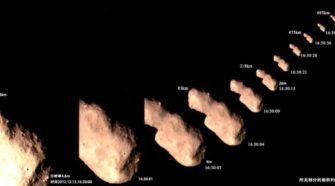This Week in History: October 4-10
OCTOBER 4, 2020: The main-belt asteroid (1679) Nevanlinna will occult the 7th-magnitude star HD 224945 in Pisces. The predicted path of the occultation crosses Newfoundland, part of the Maritime Provinces of Canada, the northeastern through the south-central U.S. (including Houston, Texas), north-central Mexico (including the northern regions of Monterrey, Nuevo Leon), and the southern Pacific …
Comet of the Week: Donati 1858 VI
Perihelion: 1858 September 30.46, q = 0.578 AU Among the many individuals who made important contributions to astronomy during the mid-19th Century was the Italian astronomer Giovanni Donati, who observed from the Observatory of Florence and who was Director of that institution from 1864 until his death (at age 46) in 1873. He made the …
Special Topic: 2008 TC3 and the Almahata Sitta Meteorite
The “Special Topics” presentation three weeks ago discussed actions that we might take should we detect an asteroid that appears will impact Earth. The first and foremost task is the collection of as much data as possible in order to refine the orbit and the likelihood of an actual impact, and if this continues to …
This Week in History: Sept. 27-Oct. 3
SEPTEMBER 27, 1858: A British portrait painter and photographer, William Usherwood, takes a photograph of Comet Donati 1858 VI, the first photograph ever taken of a comet. No copies of Usherwood’s photograph are known to exist. Comet Donati is next week’s “Comet of the Week.” SEPTEMBER 27, 1990: The Hubble Space Telescope observes Comet Levy …
Comet of the Week: The Great Comet of 1882
Perihelion: 1882 September 17.72, q = 0.008 AU What can arguably be considered as one of the brightest and most spectacular comets of the entire 2nd Millennium was a Kreutz sungrazer, one of the most pre-eminent representatives of that class of objects that is the subject of a future “Special Topics” presentation. It was first …
Special Topic: Carbonaceous Chondrites
In an earlier “Special Topics” presentation I described how meteorites are classified based upon their respective compositions. As I indicated in that presentation, the majority of known meteorites are the “stony” meteorites composed primarily of various silicates, and of these, most contain small, roughly spherical particles called “chondrules” that are primarily made up of silicates …






